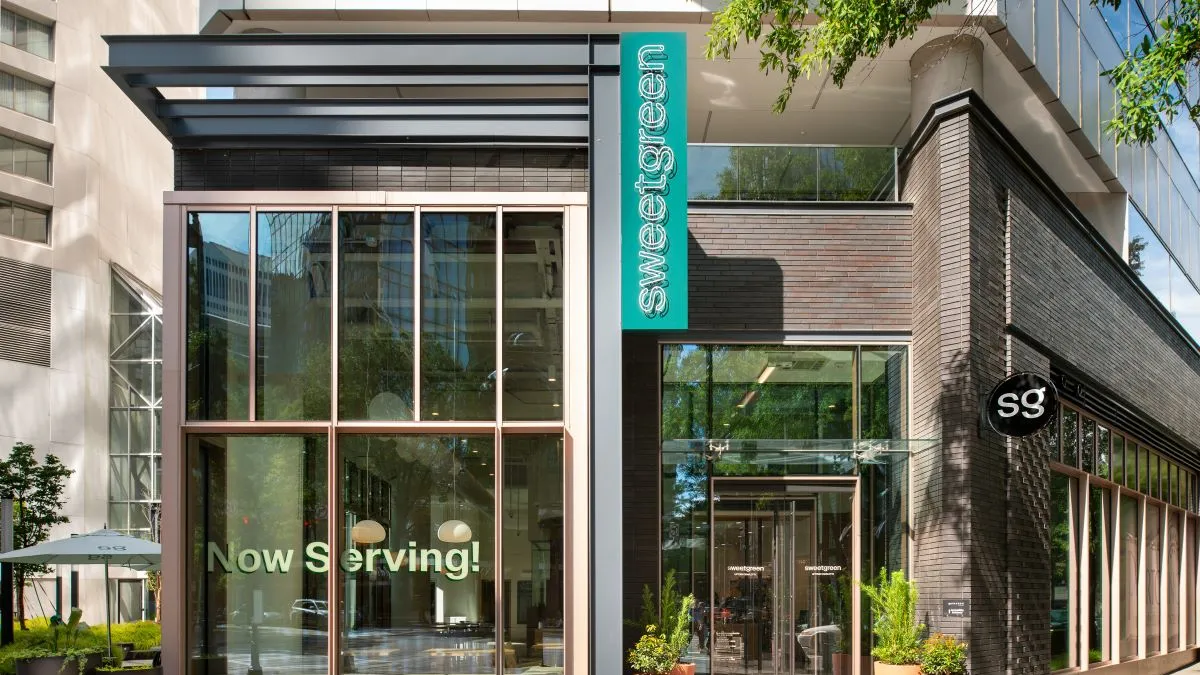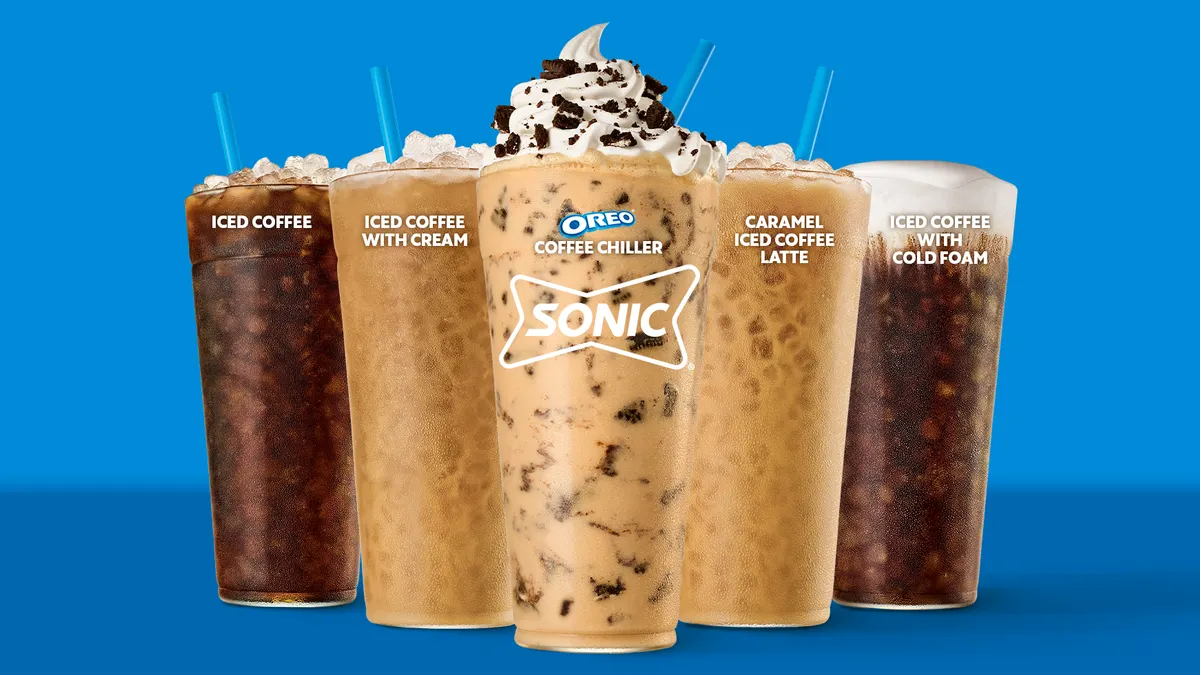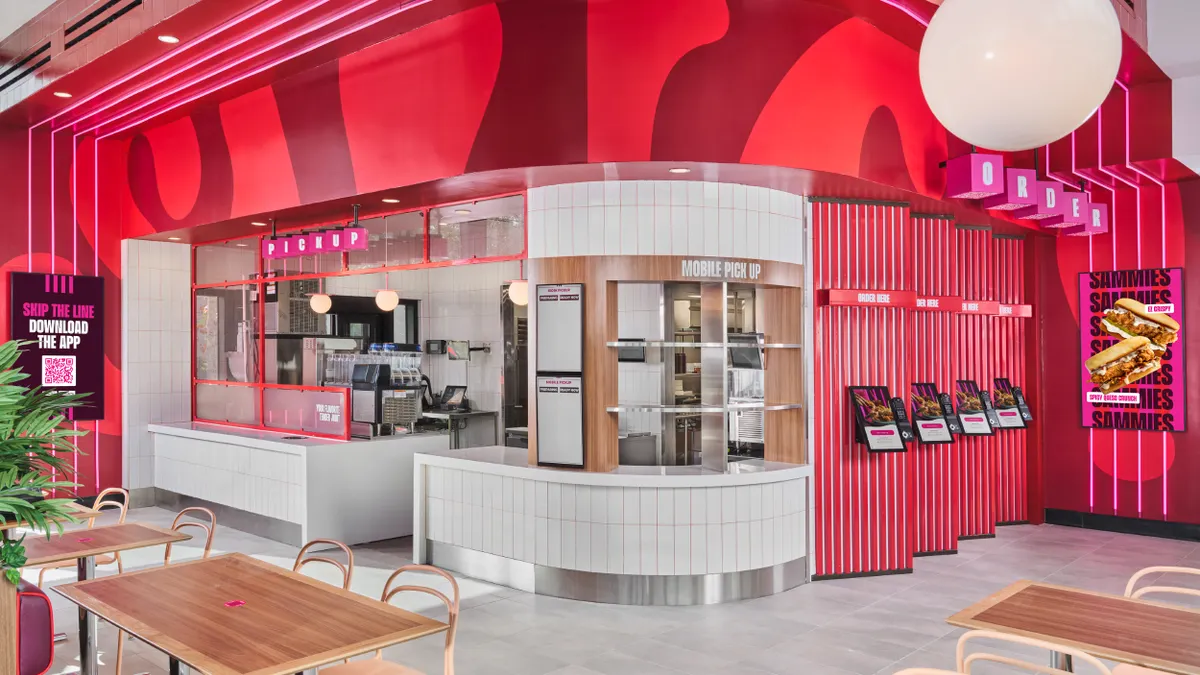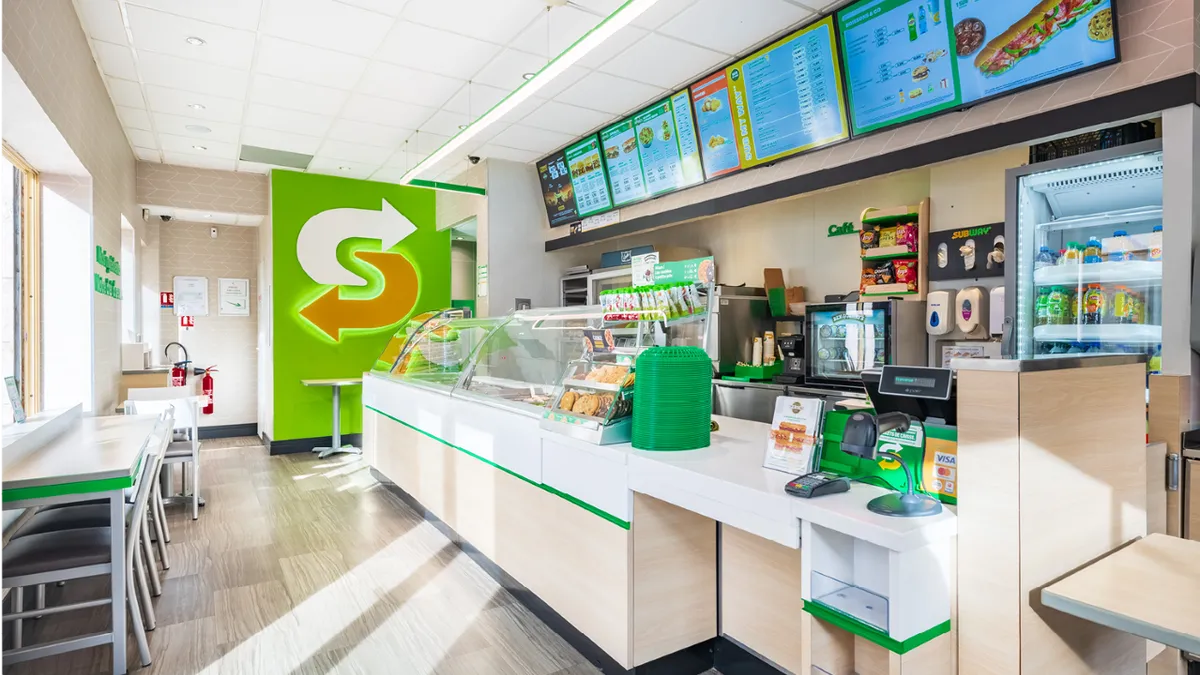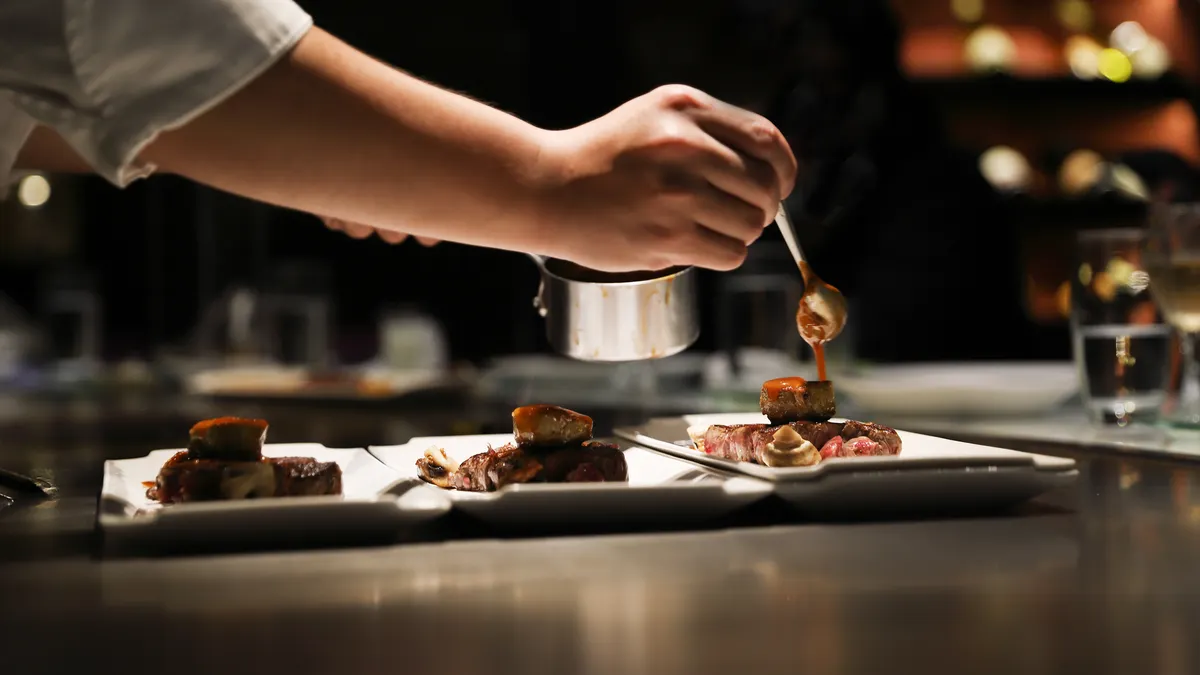This article is the third in a six-part series exploring how major restaurant cities were impacted by the pandemic. Future articles will be posted here.
Snapshot
- Restaurant closures: The number of California leisure and hospitality small businesses open declined by 48.2% between Jan. 2020 and March 3, 2021
- Restaurant job losses: 122,700 — a 33.7% decline — in Los Angeles County between Jan. 2020 and Jan. 2021
- Restaurant sales loss: Restaurant sales are down 33% the week of March 11 in Los Angeles compared to the same period in 2019
"[The government] abandoned the conversation with restaurants and instead are like, 'We're just gonna give you some random instructions and leave you out there to figure it out.'"

Caroline Styne
Co-founder, The Lucques Group
On paper, Los Angeles' near-constant sunshine, balmy weather and sprawling space should have made it the ideal restaurant market for operating amid dining room closures. But California's aggressive response to the COVID-19 outbreak — including two rounds of months-long outdoor dining bans — withered restaurant sales during "the perfect winter for outdoor dining," Caroline Styne, co-founder of restaurant group The Lucques Group, said.
"We had the driest winter yet. … It was so mild. It's colder now than it was then," Styne said last week.
Most recently, outdoor dining was closed from Nov. 25 to Jan. 9, cutting off local restaurants from seating any guests during the lucrative holiday season.
These restrictions ceded a major advantage City of Angels restaurants could have held over Midwest and Northeast markets, which struggled to lure diners to eat in igloos or huddle around heat lamps during freezing temperatures. That loss was a major point of frustration for Styne, who feels the way city officials linked on-premise restaurant dining to COVID-19 spread was unfounded.
"We were operating with outdoor dining for four months … and the cases were decreasing in the city. Then in October they opened up private gatherings … and sure enough cases increased dramatically," Styne said. "Then they shut down restaurants … not providing any sort of evidence or data to prove this is what is causing this increase. …The county used some CDC report from six months before from across the country that had nothing to do with outdoor dining; it was about indoor dining."
The frustration bubbled over in November when the California Restaurant Association took Los Angeles County to court over the outdoor dining ban, arguing that restriction was "arbitrary and capricious" because officials couldn’t provide a connection between outdoor dining and COVID-19 spread. The association won the case — a Los Angeles judge issued an injunction in early December overturning the outdoor dining closure — but it was a moot point. California's regional stay-at-home order also included an outdoor dining ban, overriding the countywide order. The city's patios remained empty.
The restriction took a toll. Los Angeles had the worst traffic declines in fine dining, QSRs and casual dining in February 2021 compared to March 2020, according to GroundTruth data analyzing Los Angeles, Seattle, Chicago, Miami, New York City and Washington, D.C., foot traffic. The city also hemorrhaged 122,700 restaurant employees — a 33.7% loss — between January 2020 and January 2021.
The county also faced devastating COVID-19 rates. In Los Angeles County, cases increased 905% between November and January, according to CNBC. Mayor Eric Garcetti said in a January interview with CBS News' "Face the Nation" that at that time, 10 people in the county were contracting COVID-19 every minute. That same month, California had higher per-capita rates of infection than any other country in the world, reporting 658 new cases per 100,000.
It's impossible to know what percentage of restaurant revenue, jobs and eateries could have been saved if outdoor dining hadn't been banned. One of the looming questions, however, is whether Los Angeles dining restrictions actually helped lower local COVID-19 rates, and if they were worth the losses the restaurant industry suffered.
How changes to dining policy in Los Angeles affected COVID-19 rates
Gov. Gavin Newsom first shut down on-premise dining on March 17 last year, allowing only takeout, delivery and drive-thru service until the end of May. Restaurant Dive calculated the percent increase of COVID-19 cases after each restaurant policy change thereafter — including restrictions and easing of capacity limits — using data pulled from the Los Angeles County Health Department.
Similar to several other large cities, rates skyrocketed in the first month no matter the restriction, as experts struggled with consistent guidance and testing protocol. Los Angeles saw an increase of 7,333% in that timeframe. Sixty days later, cases rose 19,011%.
When Newsom ordered Los Angeles restaurants to shutter outdoor dining for the second time on Nov. 25, COVID-19 cases increased 86% after 30 days. By Jan. 24, cases had increased 175%.
This data can't tell the whole story, however, since factors like travel and personal gatherings also impact COVID-19 spread. This gray area makes it challenging to gauge whether restaurant capacity restrictions can actually slow a population's contraction of the coronavirus, which has led to disparate approaches to dining guidance by local governments across the country.
"I firmly believe [transmission] was not happening in the restaurants from table to table," Styne said. "Did I see five young people outside hugging each other with their masks off saying 'Oh, I haven't seen you in so long'? Yeah, I saw that. I'm not saying people's idiotic behavior isn't the reason that this spread. But it wasn't from restaurants operating."
The need for financial support
As restrictions deeply narrowed how restaurants could bring in revenue, both Los Angeles and California released several initiatives to try to alleviate this financial burden.
Restaurant-targeted support issued by city or state
- On May 29, Mayor Eric Garcetti launched the LA Al Fresco dining program, which allows restaurants to apply to turn public spaces like sidewalks and parking lots into outdoor dining space. The program now allows for street and lane closures as well. Fifty-five percent of all the resources and applications approved for the program were earmarked for BIPOC (Black, Indigenous, People of Color) businesses or businesses located in areas that have suffered the greatest job loss due to COVID-19.
- On Sept. 9, Newsom announced the $100 million Main Street hiring tax credit program for small businesses. The hiring credit will be equal to $1,000 for each net increase in qualified employees, up to $100,000 for each qualified small business employer.
- On Nov. 25, Garcetti launched LA Optimized, an initiative to strengthen small businesses by expanding their e-commerce capabilities and growing their online presence. The mayor’s office said it would allocate over $1.5 million to help businesses with digital marketing, online business listings and e-commerce knowledge.
- Later in November, Newsom announced sales tax deferrals, including an automatic 3-month extension for taxpayers with less than $1 million in sales tax. This includes restaurants. Newsom announced the state will make $50 million in reserve funds available for grants to small businesses, nonprofits and cultural institutions. Businesses can apply for grants up to $25,000.
- In December, Los Angeles County offered $30,000 grants to 2,500 restaurant applicants as part of the Keep L.A. County Dining Great program. Thee program is no longer accepting new applications. Eligible restaurants could have no more than 25 employees; required a current health inspection of "C" or better; could have no more than 5 business locations; and had to demonstrate revenue loss caused by the pandemic. Corporate-owned franchises were ineligible.
- At the end of December, the first round of applications for the Small Business COVID-19 Relief Grant Program opened. Grants between $5,000 to $25,000 were provided to eligible businesses. The funding ended on Jan. 13.
- On Jan. 4, the first round of applications for California's Small Business COVID-19 Relief Grant Program opened and ended on Jan.13. Grants of up to $25,000 will be awarded to impacted businesses.
- On Jan. 6, Newsom introduced the $9.6 billion Golden State stimulus plan, which includes funds that can assist restaurants and bars. More than $2 billion will be issued as $25,000 grants for restaurants and other small businesses. The plan also includes two years of fee relief for bars and restaurants with California-issued liquor licenses.
- On Feb. 2, the second round of applications for California’s Small Business COVID-19 Relief Grant Program opened. The application period closed on Feb. 8.
- On March 5, the third round of applications for California's Small Business COVID-19 Relief Grant Program opened and closed on March 11. Dates for round four and round five of applications were also announced: March 16-21 and March 25-31, respectively. There will also be a sixth round, but the dates have yet to be announced.
"[Restaurants] put up a pretty front. [People don't see] the financial structure and how little we make, the pay scales, the inequity and … that our profit margins are so slim because the public just can't handle that we should be charging $40 for that salmon dish but we don't."

Caroline Styne
Co-founder, The Lucques Group
Up close: Los Angeles restaurant goes into 'survival mode'
When news hit that indoor dining would shut down in Los Angeles on March 17, Caroline Styne and Suzanne Goin, co-founders of The Lucques Group, went into "survival mode."
"We literally just looked at each other and said, 'We have to lay off our staff, because this is not just gonna be two weeks,'" said Styne, who is also a co-founder of the Independent Restaurant Coalition. "I don't know that there was a strategy, it was a lot of just reacting from that moment because we didn't see it coming."
They permanently shuttered the group's namesake restaurant, Lucques, three months earlier than planned, letting go of staff much sooner than expected. They canceled farewell dinners for the 22-year-old fine dining establishment and began calling banks and financial advisors.
"How are we going to get some financing?" Styne recalls thinking. "Because restaurant financial structure is just pathetic, and though we did have some cash in the bank at the time, I was concerned about how long will that last us," Styne said. "Suzanne immediately went into, we have inventory we need to get rid of before it goes bad so she started a program of selling food for your pantry at home."
The Lucques Group owns three additional restaurants — A.O.C, Tavern and The Larder. It also runs a catering business, a wholesale bakery that sells baked goods to hotels and eateries throughout California, and all of The Hollywood Bowl’s food operations — including multiple restaurants and concessions services.
However, after struggling to drive off-premise business across its remaining concepts while on-premise dining was banned from March until May, Styne's team decided to keep only A.O.C. operating — temporarily shuttering Tavern and The Larder. The Lucques Group's Hollywood Bowl concepts, which were handled by the financial firm and foodservice company the group is in a licensing partnership with, also went dark. The group's catering division is still available for small functions, and runs out of The Larder's kitchen, but the group's bakery business lost 80% of sales as hospitality customers canceled orders en masse, forcing the concept into hibernation.
"Doing takeaway alone does not make any sense at all; it is a huge losing proposition. So we decided to pool our resources and say okay, let's put [Tavern] on hold and not open it, not spend any money, not do anything," Styne said. "And let's put everything we have into this one [A.O.C.] that we know we can get support [for] throughout the city."
Sudden restriction changes and lack of communication fuels frustration
A.O.C.'s location makes it accessible to much of the city, Styne said, providing it decent customer traffic compared to Tavern, which felt sequestered in its corner of Brentwood during lockdown.
The wine bar also benefited from its outdoor patio when on-premise dining was allowed in May, and later expanded into a 1,600-square foot parking lot through the LA Al Fresco outdoor dining program. Styne and her team added wood fencing, string lights and an olive tree to the space, which is already covered in terra cotta pavers.
"It's still not enough to generate the revenue that we had before, but it's more than we have anywhere else," Styne said of the sales their expanded patio rakes in.
The extra tables allowed A.O.C. to rehire some staff. But when outdoor dining was shut down again in November, the restaurant was forced to lay off most of their employees for a second time, operating on a skeleton crew of mostly management.
The wine bar now employs 40 staff members — down 80 employees from pre-pandemic levels.
Styne received a Paycheck Protection Program loan in the program's first round last year, which helped bring some of those workers back. She didn't apply for restaurant-specific grants and loans offered through California or Los Angeles County because the requirements for those funding pots were too narrow for A.O.C. to qualify, she said.
Styne is disappointed by the way California and Los Angeles County have attempted to balance stringent restrictions with restaurant support.
"I don’t think it's because they don't care. … They're in this broad position of having to take care of every citizen's public safety, as well as managing the needs of the small business community," she said. "It's kind of an impossible thing [for local leaders] — you're damned if you do and you're damned if you don't… I don't think anyone has made these decisions lightly."
In June, Los Angeles County formed a task force to develop a plan alongside restaurant operators to open eateries safely, Styne said. Local restaurateurs had discussions with the task force about employee safety, guest safety, and strategies to ensure smooth operations despite restrictions, including recommendations about how to maximize seating under table-spacing requirements.
But after indoor dining shut down in July, communication between decision-makers and restaurateurs began to break down, and tensions rose, Styne said.
"They've abandoned the conversation with restaurants and instead are like ‘We’re just gonna give you some random instructions and leave you out there to figure it out,'" Styne said. "They'd be like 'Ok you can open tomorrow!' — after we've been shuttered for months. 'We're not really gonna explain why, but you can open tomorrow.'"
Styne believes these sudden changes are the result of political pressure mounting against Newsom for his approach to COVID-19 safety, and that lack of lead time and communication around these policy shifts have made it difficult to know if your restaurant is in full compliance with new standards. This stress is exacerbated by the presence of Newsom's "strike teams," made up of representatives from 10 state regulatory agencies, which are tasked with cracking down on bars and restaurants that are not compliant.
"It's been such a crazy back and forth of emotion and conversation and anger and calm over the whole thing," Styne said. "And we restaurateurs have been in this sort of impossible position of taking the brunt of the shutdowns and make some impossible decisions about safety for our employees, for ourselves and for our guests, and commerce."
Not every restaurant feels as strongly about the local government's restrictions and its communication of those roadblocks, however. Ali Elreda, owner of Fatima's Grill in Downey, says that though keeping up with restrictions at times felt like "you’re in the middle of a high-speed chase and somebody says you have to make a U-turn because you forgot something," he feels Los Angeles County has done the best job it could have.
"I don't think we can judge L.A. County's response to this … on a scale of 1 to 100… they've done absolutely the best job that they can do," Elreda said. "This is new to everybody. This is like something out of a movie that we would watch and say, 'This is never gonna happen.'"
Elreda's business, however, wasn't hit hard by local restaurant restrictions. Fatima's Grill, located in a strip mall, took advantage of a large parking lot adjacent to its storefront and set up a tent, tables and chairs to help sales. The business also went viral on TikTok for its Hot Cheetos burritos and burgers, which drove a surge in interest in takeout orders — lifting 2020 sales 50%.
Looking toward the future
While Los Angeles' restaurant scene has been shaken by a year of stringent restrictions and sky-high infection rates, there is cause for optimism.
Restaurants have been able to seat diners at a quarter of their indoor capacity since Monday, and Los Angeles County Department of Public Health Director Barbara Ferrer said late last month that case counts have reached lows the city hasn't experienced before the winter's uptick in cases. Between Feb. 14 and Feb. 22, Los Angeles County daily cases dropped 88% from early January.
Restaurant employees have also been eligible for the COVID-19 vaccine since March 1, which could help operators maintain consistent staffing.
How Los Angeles' restaurant foot traffic shifted a year after the pandemic
Outdoor dining could become a more dominant feature of Los Angeles' restaurant landscape. The city's LA Al Fresco outdoor dining program has been extended through June, Styne said, and the local government is considering making the program permanent.
It could take time for diners to adjust, however, to the changes restaurants have made to survive. Styne estimates her restaurants probably won't see normal diner traffic until 2022.
"I think people are going to have PTSD and not feel comfortable being in a crowd. ... So reliance on takeaway is going to be pretty strong in the future, while in the past that had just been, not even secondary, more like fourth generation for us in terms of focus," Styne said. "Even if it's only 10% [of A.O.C.’s business] it was not nearly 10% before. We're at 20% [takeaway now]."
Styne is hopeful that as the city continues to open up, the creativity of Los Angeles' restaurant community will begin to come back to life.
"I think the temporary cessation of innovation in L.A. will be short-lived because there are a lot of people with aspirations, thank God, and I think people are anxious to open new restaurants," Styne said. "I see the beginnings of that happening around us all day long. And I think that energy and momentum will continue … and we might see some interesting concepts come out of this."
There is new growth ahead for Lucques Hospitality, too — the group is opening new restaurants in The Proper Hotel in May. But that doesn't mean recovery won't be challenging.
"As vaccinations continue to increase, we look towards a reversal of job losses and a wave of reopenings and hiring. However, the unfortunate truth is that many restaurants have closed for good, and related jobs won't return in the immediate future," Lawren Markle, senior director of communications for the Los Angeles County Economic Development Corporation, said.
Styne had hoped that the pandemic would spark a new sensitivity among diners for the fragility of the restaurant business and that customers would tolerate higher menu prices to stabilize operations. She isn't sure, however, that the restaurant industry's razor-thin margins will be something the public will be aware of in the long term because "having that sort of stuff on the front of their minds is not the most romantic thing."
"We want people to come in and escape their lives and enjoy themselves," Styne said. "We in the restaurant business are very much like theater producers … we put up a pretty front. [People don't see] the financial structure and how little we make. … The public just can't handle that we should be charging $40 for that salmon dish but we don't."











